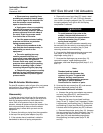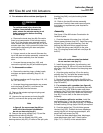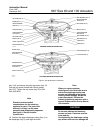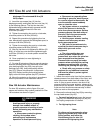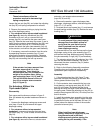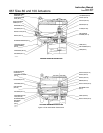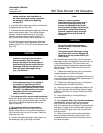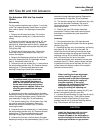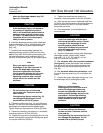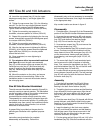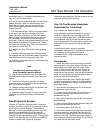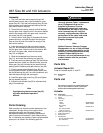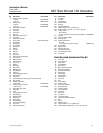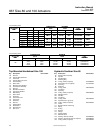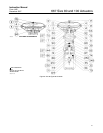
667 Size 80 and 100 Actuators
Instruction Manual
Form 1432
December 2007
14
For Actuators With the Top-Loaded
Option
Disassembly
For key number locations refer to figure 7, and refer
to the Top-Loaded Actuator Detail shown in figure 7.
Also, refer to figure 5 for diaphragm construction
details.
1. Remove the 40 cap screws (key 13) from the
upper diaphragm casing (key 1) and remove the
casing.
2. Remove the travel stop cap screw (key 12), hex
nuts (key 24 and 241), washer (key 37), backup
plate (key 6), diaphragm retainer (key 5), diaphragm
(key 3), and diaphragm backup plate (key 246) with
O-ring (key 240).
3. Remove the 40 cap screws (key 13) from the
lower side of the casing adaptor (key 245) and
remove the adapter.
4. Remove the diaphragm plate (key 4) with O-ring
(key 240), diaphragm (key 3), diaphragm retainer
(key 5), and backup plate (key 6).
5. Unscrew the six cap screws (key 11) and remove
the seal bushing retainer (key 10). Remove the seal
bushing (key 7). Remove and replace the seal
bushing O-rings (keys 8 and 9) as necessary.
WARNING
To avoid personal injury due to the
sudden, uncontrolled movement of
parts, do not loosen the four hex nuts
on the lower diaphragm casing when
spring pressure is applied. Ensure that
all spring precompression has been
released.
6. Unscrew the four hex nuts that secure the lower
diaphragm casing to the yoke assembly (key 67) and
remove the lower diaphragm casing. Replace the
yoke assembly O-rings (key 70) as necessary.
7. The actuator spring (key 18) and stem (key 144)
can now be removed if necessary. Be sure to
disconnect the stem connector (key 31) before
removing the stem.
8. Unscrew the six cap screws (key 11) and remove
the seal bushing retainer (key 10). Remove the seal
bushing (key 7). Remove and replace the seal
bushing O-rings (keys 8 and 9) as necessary.
9. Unscrew the four hex nuts that secure the lower
diaphragm casing to the yoke assembly (key 67) and
remove the lower diaphragm casing. Replace the
yoke assembly O-rings (key 70) as necessary.
10. The actuator spring (key 18) and stem (key 144)
can now be removed if necessary. Be sure to
disconnect the stem connector (key 31) before
removing the stem.
11. Refer to the size 100 actuator assembly
procedures. Carefully clean and inspect all parts,
and obtain any replacement parts required for
reassembly.
Assembly
1. If the actuator stem (key 144) was removed,
lubricate the threads on the stem with lithium grease
lubricant (key 237).
2. Assemble the hex nuts, thrust bearing, and spring
seat (keys 26, 25, 86, and 19) to the stem. Be
certain that the thrust bearing race with the larger
inside diameter faces the spring seat. Rotate the
adjusting nut (key 25) to position the spring seat 305
mm (12 inches) from the end of the stem.
3. Install the actuator stem assembly into the yoke
assembly (key 67). Place a support under the stem
to position the lower end of the stem 254 mm (10
inches) above the bottom surface of the actuator
(actuator-to-bonnet joint).
Note
When installing the lower diaphragm
casing, install O-rings (key 70) into
grooves found in the lower diaphragm
casing before placing the casing on
the yoke assembly. If the spring
interferes with installation of the lower
diaphragm casing, reposition the
spring by rotating the adjusting nut.
4. Install the lower diaphragm casing (key 67), and
secure it by tightening the four hex nuts.
5. Lubricate the seal bushing O-rings (keys 8 and 9)
and the seal bushing (key 7) with lithium grease
lubricant. Install the seal bushing O-rings, seal
bushing (keys 8 and 9), and seal bushing retainer
(key 7) and secure with four hex nuts.
CAUTION
Install the diaphragm with the fabric
side facing away from the spring.
Smooth the edge of the diaphragm to
avoid wrinkling and be careful that the
diaphragm fold does not get pinched




